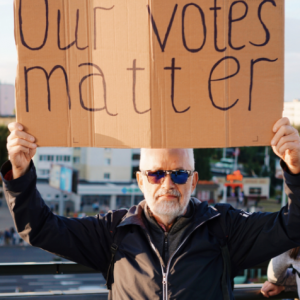Vote Of Confidence? Lots Of Obstacles To Voting This Fall

Vote Of Confidence? Lots Of Obstacles To Voting This Fall
September 2, 2020
Anyone with a pulse is probably aware that we are heading toward consequential elections this fall and that voters are likely to face many obstacles, whether they plan to vote in person or by mail. Especially for older voters, who in previous elections showed up at the polls in greater numbers than any other demographic, the stakes in this election may be very high- both personally and politically. Whether you’re passionate that your chosen candidate is victorious, or you just want to make sure you’re protected from the coronavirus, it’s important for all voters to “plan their vote,” this year. This requires a strategy and perseverance, especially for those who may need some extra help.
To start, one thing is clear, regardless of the rhetoric you hear: Mail-in and absentee balloting does not inherently favor one party over another. All parties and candidates will benefit if voters are able to cast their votes from a distance this year. With fear of the virus, fewer polling places, and fewer poll workers all limiting in-person voting options, it’s quite reasonable for voters of any party to determine their best bet is to stay safe, stay home and vote well in advance. For some useful advice about how to do so in your own state, get ready to check that box and click here.
But for one category of older voters, it’s going to be a herculean challenge to make their voices heard at the ballot box this year. Residents of long term care facilities, which have previously housed polling stations within their facilities to allow residents to vote, are going to be at an extreme disadvantage. Given the number of COVID-19 infections and deaths within nursing homes and assisted living facilities (with over 65,000 deaths, along with a new upsurge in COVID infections), as well as demands on staff, residents of such facilities will likely not have the same assistance they’ve had in previous years that allowed them to exercise their right to vote. According to Professor Nina Kohn, an expert on elder voting at Syracuse University, older voters already start with obstacles due to mobility and cognitive issues. And even though nursing homes have the legal obligation to allow residents to exercise their rights of citizenship, this often means that staff needs to help or groups need to come into the facility to facilitate the actual voting process. But not this year. Despite the fact that 2.2 million Americans live in such facilities, a significant portion could be disenfranchised this year due to states eliminating programs to help and restricting staff from assisting with the execution of the ballot, on top of visitor restrictions to such facilities. As one source made clear, “With strict limits still in place on the ability of elderly residents to leave facilities, and prohibitions on friends and relatives coming inside, the looming 2020 elections are presenting the nation’s 15,000 nursing homes with an unprecedented clash of priorities — balancing between protecting public health and securing the foundational American right to vote.”
There is one organization stepping up to the plate to help those who are ill and unable to head to a polling place still exercise their right to vote. The non-partisan group Patient Voting is trying to help those with unexpected and emergency illnesses still make sure their vote counts. While this group focuses on emergency absentee voting, it’s encouraging to see that there are non-partisan groups out there trying to make sure that some of our most vulnerable citizens still have the chance to participate in our democracy. To learn more about this and other such groups, read here. And if you feel courageous and COVID-free, and want to do your part to ensure access to voting, consider becoming a poll worker (a position for which you can be paid) by clicking here.







